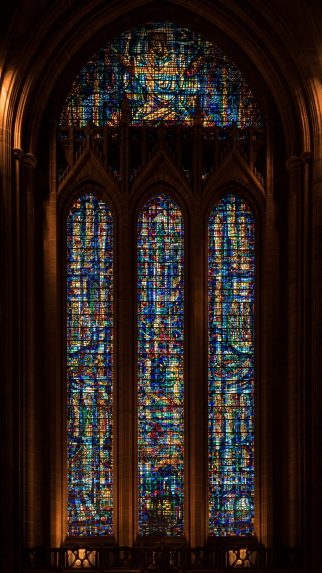Liverpool Cathedral, Merseyside (Lancashire)
Address
Cathedral Church of Christ, St James Mount, Liverpool L1 7AZTheme
Overview
The cathedral has a fine collection of 20th century windows with major contributions from James Powell & Sons (successively under J W Brown and James Hogan), William Wilson and Carl Edwards, with the baton sadly often passing from one to the other due to death or ill-health.
Of particular note for their subject matter are the ‘Noble Women’ windows on the Lady Chapel stairs. The 23 glass panels focus on the achievements and impact of women in society – a particularly progressive approach when one considers that they were made in the early twentieth-century. The windows were designed by JW Brown and made by Powells in 1910, but were unfortunately damaged during World War Two. The task of making replacements was begun by James Hogan on the south side using simplified versions of the original designs. After his premature death in 1948 the work was completed by Carl Edwards, who also made a new east window for the chapel.
Highlight
Great west windowArtist, maker and date
Carl Edwards, 1979Reason for highlighting
The imposing Great West window was dedicated in 1979 and contains over 1,600 square feet of glass. It was the culmination of Carl Edwards work in the cathedral. Its glorious colours and strong design deserve attention, even if not all will feel that Tracey Emin’s florescent light design beneath is an enhancement or a complement.
Artist/maker notes
Carl Johannes Edwards (Kiviaho) 1914-1985 was born in London to Finnish parents. He joined James Powell & Sons in 1928, and became assistant to the chief designer James Hogan in 1936, before succeeding him in 1948. In 1952 he set up his own studio, briefly with Hugh Powell. The studio relocated to The Glass House in 1972, where he took over the firm of Lowndes & Drury.
Source: Benyon Stained Glass website


Comments by
Peter Hildebrand